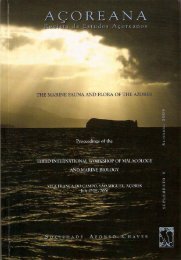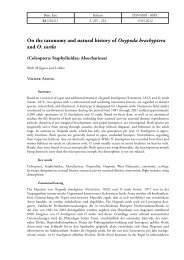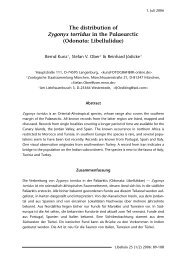(eds.) (2005). - Portal da Biodiversidade dos Açores - Universidade ...
(eds.) (2005). - Portal da Biodiversidade dos Açores - Universidade ...
(eds.) (2005). - Portal da Biodiversidade dos Açores - Universidade ...
Create successful ePaper yourself
Turn your PDF publications into a flip-book with our unique Google optimized e-Paper software.
a) Quantas espécies endémicas existem realmente<br />
nos <strong>Açores</strong>?;<br />
b) Como é que a capaci<strong>da</strong>de de dispersão <strong>dos</strong> diferentes<br />
taxa está relaciona<strong>da</strong> com a sua distribuição<br />
nas ilhas?;<br />
c) Estarão as espécies exóticas a seguir os mesmos<br />
padrões ecológicos e biogeográficos <strong>da</strong>s espécies<br />
indígenas?;<br />
d) Mostrámos que uma grande proporção <strong>da</strong>s espécies<br />
endémicas de briófitos e plantas vasculares<br />
ocorriam na maior parte <strong>da</strong>s ilhas. Deste modo,<br />
será importante investigar a distribuição de frequências<br />
<strong>da</strong>s suas abundâncias e relacionar os<br />
padrões observa<strong>dos</strong> com a rari<strong>da</strong>de real ou a<br />
pseudo-rari<strong>da</strong>de;<br />
e) Quais são os factores relaciona<strong>dos</strong> com a taxa<br />
de especiação nos Mollusca e Arthropo<strong>da</strong>?<br />
Serão os factores históricos realmente importantes?<br />
Qual é o papel <strong>da</strong> área e <strong>da</strong> diversi<strong>da</strong>de<br />
de habitats?;<br />
f) Estará a diversi<strong>da</strong>de <strong>dos</strong> vários taxa terrestres<br />
relaciona<strong>da</strong> com os mesmas variáveis ecológicas<br />
e biogeográficas, e como é que esses padrões<br />
variam em escalas diferentes?<br />
Para a primeira <strong>da</strong>s questões, apresentámos já<br />
uma proposta de resposta neste capítulo. Enquanto<br />
que o número de endemismos se deve aproximar<br />
<strong>da</strong>s 530 espécies para briófitos, plantas vasculares,<br />
moluscos e artrópodes (apenas carca de 77% terão<br />
sido até à <strong>da</strong>ta descritas; ver Fig. 14), o número global<br />
de espécies será possivelmente um número de<br />
difícil estimação. De facto, conhecemos pouco acerca<br />
<strong>dos</strong> organismos mais pequenos e/ou taxonomicamente<br />
difíceis, quer nos <strong>Açores</strong> quer no resto do<br />
planeta, e a falta actual de taxonomistas torna o inventário<br />
<strong>da</strong> biodiversi<strong>da</strong>de uma tarefa ca<strong>da</strong> vez mais<br />
complexa. Muito trabalho haverá para efectuar até<br />
ser possível obter uma lista quase completa <strong>da</strong> fauna<br />
e flora terrestres <strong>dos</strong> <strong>Açores</strong>. De facto, grupos como<br />
os fungos, líquenes, nemáto<strong>dos</strong> e anelídeos estão<br />
muito mal estu<strong>da</strong><strong>dos</strong> (ver Apêndices 2 e 3) e muito<br />
mais trabalho precisa ain<strong>da</strong> de ser efectuado com os<br />
artrópodes (ver Fig. 12c). A ausência de informação<br />
básica sobre a história natural <strong>dos</strong> artrópodes endémicos<br />
<strong>dos</strong> <strong>Açores</strong> implica uma grande lacuna na<br />
62<br />
related with their distribution?;<br />
c) Are exotic species following the same ecological<br />
and biogeographical rules of indigenous<br />
species?;<br />
d) We showed that a great proportion of endemic<br />
bryophytes and vascular plants occur in most<br />
islands. Therefore, it will be important to investigate<br />
the frequency distribution of their<br />
abun<strong>da</strong>nces and relate the observed patterns<br />
with real and pseudo-rarity;<br />
e) What are the factors related with speciation<br />
rate in Mollusca and Arthropo<strong>da</strong>? Are historical<br />
factors really important? What is the role<br />
of geographical area and habitat diversity?<br />
f) Are the diversity of the several terrestrial taxa<br />
related with the same ecological and biogeographical<br />
variables, and how does this vary<br />
with spatial scale?<br />
For the first question we have already presented<br />
in this chapter a tentative response. Whilst<br />
the number of endemics will approximate the 530<br />
species for bryophytes, vascular plants, molluscs<br />
and arthropods (only about 77% have been yet<br />
described; see Fig. 14), the overall number of<br />
species (including also the natives and exotics)<br />
will probably be a number of difficult estimation.<br />
In fact, we know little about small and taxonomically<br />
difficult organisms in the Azores and<br />
elsewhere on the planet, and the taxonomic<br />
impediment makes the inventory of the diversity<br />
even more difficult.<br />
Much more work has to be performed to reach<br />
an almost complete list of the Azorean terrestrial<br />
biodiversity. In fact, groups like fungi, lichens,<br />
nematodes and annelids are poorly investigated<br />
(see Appendices 2 and 3) and more work ne<strong>eds</strong> to<br />
be done on arthropods (see Fig. 12c).<br />
Fun<strong>da</strong>mental <strong>da</strong>ta of natural history are lacking<br />
for most endemic arthropod species, which<br />
implies that we do not have sufficient information<br />
for optimising conservation management practices.<br />
This does not hold true for vascular plant species,<br />
as the work of LIFE programs (Dias et al. 2004)<br />
greatly improved the knowledge of the current

















